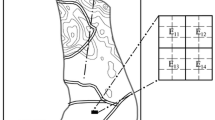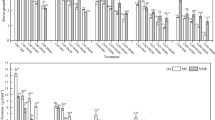Abstract
A long-term field experiment was designed to assess remediation efficiency and ecological risk of phytoremediation of Cd under different cultivation systems with or without ethylene diamine tetraacetic acid (EDTA). EDTA can significantly improve the phytoremediation effectiveness of a historically polluted e-waste dismantling site through enhancing Cd uptake by plants in all cultivation systems along with higher ecological risks to different receptors especially in the presence of Cicer arietinum (chickpea). Moisture content at each layer of soil profile under Eucalyptus globules L. cultivated sites was consistently lower than under chickpea monoculture as a result of E. globules’ high water use efficiency. Besides low soil moisture, E. globules can intercept more Cd-rich leachate than chickpea regardless of the presence of EDTA. E. globules could be used for Cd phytoremediation as they can take full advantage of EDTA and decrease ecological risk caused by the chelator.
Similar content being viewed by others
References
Choi Y, Jeong S, Ryu H, Lee K, Bae BH, Nam K (2011) Ecological risk characterization in a military heavy metals- and explosives-contaminated site. Hum Ecol Risk Assess 17:856–872
Dai GX, Zhang T, He JF, Feng ZY, Liang L (2009) Guangdong rodents flea populations and parasitic surface survey. Chin J Pest Control 25:170–172
Duarte B, Freitas J, Cacador I (2011) The role of organic acids in assisted phytoremediation processes of salt marsh sediments. Hydrobiologia 674:169–177
Ehsan S, Ali S, Noureen S, Mahmood K, Farid M, Ishaque W, Shakoor MB, Rizwan M (2014) Citric acid assisted phytoremediation of cadmium by Brassica napus L. Ecotoxicol Environ Saf 106:164–172
Forrester DI, Bauhus J, Cowie AL (2006) Carbon allocation in a mixed-species plantation of Eucalyptus globulus and Acacia mearnsii. For Ecol Manag 233:275–284
Forrester DI, Theiveyanathanc S, Collopya JJ, Marcar NE (2010) Enhanced water use efficiency in a mixed Eucalyptus globulus and Acacia mearnsii plantation. For Ecol Manag 259:1761–1770
Gomes MP, Marques TCLLSM, Carneiro MMLC, Soares ÂM (2012) Anatomical characteristics and nutrient uptake and distribution associated with the Cd-phytoremediation capacity of Eucalyptus camaldulenses Dehnh. J Soil Sci Plant Nutr 12:481–495
Gonçalves J, Stape J, Laclau JP, Bouillet JP, Ranger J (2008) Assessing the effects of early silvicultural management on long-term site productivity of fast-growing eucalypt plantations: the Brazilian experience. South For 70:105–118
Kambhampati MS, Vu VT (2013) EDTA enhanced phytoremediation of copper contaminated soils using chickpea (Cicer aeritinum L.). Bull Environ Contam Toxicol 91:310–313
Liu ZY, Sun T, Yuan F, Cheng XY (2011) The effects of temperature on the behaviors of free-ranging chicken in the alpine grassland. Pratacultural Sci 28:1370–1373
Liu MX, Yang YY, Yun XY, Zhang MM, Li QX, Wang J (2014) Distribution and ecological assessment of heavy metals in surface sediments of the East Lake, China. Ecotoxicology 23:92–101
Liu K, Lv JL, He WX, Zhang H, Cao YF, Dai YC (2015) Major factors influencing cadmium uptake from the soil into wheat plants. Ecotoxicol Environ Saf 113:207–213
Luo J, Qi SH, Peng L, Xie XM (2015) Phytoremediation potential of cadmium-contaminated soil by Eucalyptus globulus under different coppice systems. Bull Environ Contam Toxicol 94:321–325
Madrid F, Liphadzi MS, Kirkham MB (2003) Heavy metal displacement in chelate-irrigated soil during phytoremediation. J Hydrol 272:107–119
Pulford ID, Watson C (2003) Phytoremediation of heavy metal-contaminated land by trees – a review. Environ Int 29:529–540
Qu GZ, Tong YA, Gao PC, Zhao ZP, Song XY, Ji PH (2013) Phytoremediation potential of Solanum nigrum L. under different cultivation protocols. Bull Environ Contam Toxicol 91:306–309
Raj A, Singh N (2015) Phytoremediation of arsenic contaminated soil by arsenic accumulators: a three year study. Bull Environ Contam Toxicol 94:308–313
Ren XT, Yang YY, Zhang N, Wang ZL, Li YW, Lu JQ (2011) Effects of photoperiods on circadian rhythm and activity of mandarin voles and kunming mice. Chin J Zool 46:32–39
Robinson BH, Mills TM, Petit D, Fung LE, Green SR, Clothier BE (2000) Natural and induced cadmium-accumulation in poplar and willow: implications for phytoremediation. Plant Soil 227:301–306
Schmidt BO (2001) Appraisal of the electrical octet method for estimating earthworm populations in arable land. Ann Appl Biol 138:231–241
Seyfferth AL, Parker DR (2007) Effects of genotype and transpiration rate on the uptake and accumulation of perchlorate (ClO4 −) in lettuce. Environ Sci Technol 41:3361–3367
Shi ZM, Xu L, Hu F (2014) Progress in earthworm biomarker studies and theirs applications in soil pollution risk assessment. Acta Ecol Sin 34:5369–5379
Soltani A, Sinclair TR (2011) A simple model for chickpea development, growth and yield. Field Crop Res 124:252–260
Turgut C, Pepe MK, Cutright TJ (2004) The effect of EDTA and citric acid on phytoremediation of Cd, Cr, and Ni from soil using Helianthus annuus. Environ Pollut 131:147–154
USEPA (1992) Framework for ecological risk assessment. EPA/630/R-92/001, Washington, DC
USEPA (2005) ecological soil screening levels for cadmium. OSWER Directive 9285.7-65, Washington, DC
Vervaeke P, Luyssaert S, Mertens J, Meers E, Tack FMG, Lust N (2003) Phytoremediation prospects of willow stands on contaminated sediment: a field trial. Environ Pollut 126:275–282
Vigil M, Marey-Pérez MF, Huerta GM, Cabal VÁ (2015) Is phytoremediation without biomass valorization sustainable? – Comparative LCA of landfilling vs. anaerobic co-digestion. Sci Total Environ 505:844–850
Wong CSC, Duzgoren-Aydin NS, Aydin A, Wong MH (2007) Evidence of excessive releases of metals from primitive e-waste processing in Guiyu, China. Environ Pollut 148:62–72
Wu L, Zhang MW, Li B (1998) Studies on the food composition of Microtus fortis in Dongting lake area. Acta Theriol Sin 18:282–291
Wu EGL, Zhang BJ, Zhang JS, Ali MJ (2008) Effect of planting density on growth characters, yield and quality of chickpeas (Cicer arietinum L.). Agr Res Arid Areas 26:95–99
Yang YG, Li FL, Bi XY (2011) Lead, zinc, and cadmium in vegetable/crops in a zinc smelting region and its potential human toxicity. Bull Environ Contam Toxicol 87:586–590
Acknowledgments
We gratefully acknowledge the financial support from Department of Finance of Guangdong Province. Thanks are also given to our colleagues for their supplies and assistance.
Author information
Authors and Affiliations
Corresponding author
Rights and permissions
About this article
Cite this article
Luo, J., Qi, S., Gu, X.W.S. et al. Ecological Risk Assessment of EDTA-Assisted Phytoremediation of Cd Under Different Cultivation Systems. Bull Environ Contam Toxicol 96, 259–264 (2016). https://doi.org/10.1007/s00128-015-1678-2
Received:
Accepted:
Published:
Issue Date:
DOI: https://doi.org/10.1007/s00128-015-1678-2




